Serene, Rachel, May, Maria, David and Patrik have just left Vava'u after an amazing ten days on the water with humpback whales.
As I've mentioned in previous posts, it's been a relatively difficult season, with seemingly fewer whales around than normal (at least, fewer whales willing to stick around and play for a bit), and what whales are here seem to be unsettled, mostly on the go.
Despite this challenging backdrop, we've had some mind-blowing encounters over the past week and a half, including: a few new baby whales; multiple repeat encounters with Ikumi (the 5th ID-ed humpback whale calf of this season); a totally crazy day in the water with pilot whales, oceanic whitetip sharks, and a striped marlin (not to mention humpback whales); an interesting four-hour swim with three socialising adult male humpbacks; and to wrap up…an all-day encounter with a seven-whale heat run that involved bubble-blowing, tail-slapping, grunting, snorting, lunging, and breaching.
In short…wow.

Toku (11th ID-ed humpback calf) with mother
Baby Humpback Whales
Since my last update, our humpback whale calf ID count has increased to 11 baby whales. We've named the new ones:
- Geri
- Lele
- Yoshi
- Kurosuke
- Toku
We're slightly behind the count as of the same dates in the past two years (14 and 12 at the same time in 2009 and 2008, respectively), but so far, the build-up in calf sightings seems to be following a similar pattern.
The big calf story, however, is Ikumi, calf number 5 this season.
We've now photographed her on ten separate occasions over the past 14 days. That's blown away our previous sighting record for any previous calf, which was four times.
Since we first saw her on 17 August, Ikumi has blossomed from teeny baby to large, extroverted humpback whale.
She plays a lot, both alone and with swimmers in the water. Her mom has grown accustomed to people in the water, and doesn't seem to mind having (reasonable) people and boats around. Basically…Ikumi enjoys being the centre of attention.
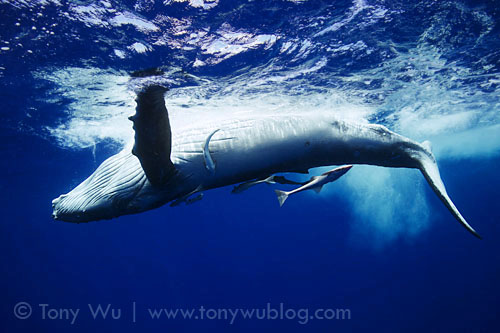
Ikumi (5th ID-ed humpback calf) playing during our 7th encounter
To convey a sense of the change over time, here is an excerpt from my notes from our first encounter: "It was difficult to get near them in the water"; and our second: "Mom was very cautious".
Now, both mom and baby seem just as happy as can be when people are around.
With the adult and baby whale both so comfortable with our presence, I tried something different on 26 August, which was our sixth encounter with the pair.
When humpback whale babies surface to breathe, they sometimes play for a bit before swimming down to rest next to mommy. Typical play comprises swimming in big circle, splashing a bit, hanging head-down in the water, and turning upside down with belly at the surface and head arching back.
On one occasion when Ikumi came up, I did my best impression of a baby whale, flipping upside down with belly to the surface and head arched back, as well as hanging head-down, fins-up and twirling.
Ikumi looked befuddled, giving me the "Huh?" expression (that I so often get, irrespective of species), and went back down to the sanity of her mother's side.
So much for bright ideas, right?
Well…on the next day, during our seventh encounter, I did the same, and boy did she react. I don't know if she remembered what I did the day before, or if perhaps she was in a different mood, but as soon as she saw my baby whale impression, she went nuts!
Soon, we were both hanging upside down, watching each other twist, twirl and flop (me doing much of the flopping; she doing more twisting and twirling). As I did my best to act like a baby humpback, Ikumi seemed to delight in saying: "No, no, no. Let me show you how it's done", and then…well, showing me how it's done.

Hanging upside down together with Ikumi
I know it sounds far-fetched, but I have witnesses who were in the water and on the boat, all watching Ikumi struggle to educate me.
Of course, we were making a huge racket at the surface, so I kept an eye on mommy, who…just sat there, about 12 metres directly underneath us.
At times, I could hear the baby making sounds, so whatever sounds she was making must've been happy ones, perhaps akin to "wheeeeee!!!!!" or "whoooppeeeee!!!!!", because mom didn't budge.
As a result of my antics, Ikumi stayed at the surface the entire time her mom was resting. This may not sound like much, but to me...it's a really big deal.
As I mentioned earlier, normally babies go to the surface, breathe, play a bit and go back down. Typically, they'll do this several times before mommy comes up for a breath, and then they repeat the cycle.
For a baby to come up and stay up implies several things.
First, Ikumi was having fun. There's no other way to put it. Forget the dictum not to ascribe human traits to animals. Ikumi was having fun. Period. And she felt secure enough not to go back to mommy's side.
Second, mom was completely comfortable. Each play session (we had three extended play sessions that day), lasted well over 15 minutes, probably closer to 20+ minutes. Mommy never budged, even without the periodic tactile feedback/ communication mother and baby engage in when the infant returns to its mother's side.
Third, and most important, I speak baby whale.
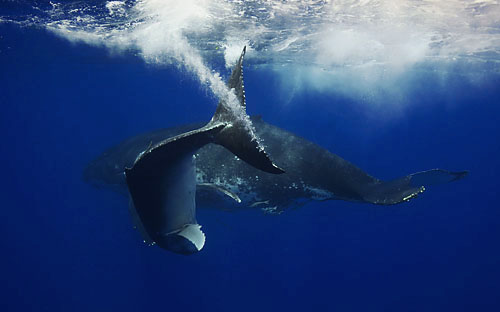
Ikumi saying "Whooppeeeee!!!"
In all seriousness, I've never seen a baby stay at the surface for the entire duration of its mother's breath cycle, and certainly not repeatedly. (It happened twice again the next day.)
Besides being special in a magical-Disney-moment sort of way, Ikumi and mom are intriguing in another respect.
Since I started recording calf encounters in a methodical manner in 2008, the most encounters we've had with any single calf was four times (Val, calf 13/ 2008 and Stitches, calf 4/ 2009).
Most calfs we see between one and three times, and then never again.
I had assumed that this was indicative of the fact that humpback whale mothers and their babies use Vava'u as a stopover to/ from other places, not necessarily spending a lot of time here.
I still think this is probably the case, and that Ikumi and mom may be outliers.
It's certainly possible, though, that moms and babies are spending more time around Vava'u in general, and we've somehow missed having more repeat sightings in the past. I ascribe a lower possibility to this scenario though, given the number of boats on the water.
Outliers are always interesting, because exceptions to the rule often illuminate otherwise obscure aspects of the general rule.
So I've been asking myself repeatedly…what is the difference between Ikumi and all the other calfs? Or perhaps, what is the difference in the circumstances in which Ikumi finds herself, as compared to other calfs?
The "Aha!" moment came when I considered the relative dearth of whales this year.
There just aren't as many whales around as we'd normally expect.
I'm speculating that perhaps one of the primary factors underlying the apparent mobility of mothers and calfs in more "normal" years is pressure from other whales.
With a given quantity of baby-friendly real estate, the more whales there are, the more crowded it'll be on average…meaning the greater the pressure there is to find someplace more peaceful.
We've sighted Ikumi and mom in areas that are generally popular with mothers and babies…but importantly…we haven't seen many other mothers and babies in these areas over the past two weeks. Or any other whales for that matter.
In a more typical year, there might be more mothers and calfs, as well as other whales (such as potential escorts), that might exert pressure on a given mother and calf…leaving them with little elbow room, so to speak, and forcing them to move on.
Again, this is speculation on my part, but 14 days (and counting) versus four days is a significant difference, so there must be some underlying reason.
Other moms and babies we've sighted this season have not stuck around for so long (as far as we're aware), so another possibility could also be that Ikumi's mom is spectacularly lazy.
Everything but the Whale Shark
There are some days in your life that you'll never forget. The 25th of August was one of those days for me.

Pilot whale swimming at depth
The day started off well, with a new mother and calf, which I named Lele…the Tongan word that means "to run", as the pair moved constantly, and it was a challenge keeping up with them.
After several drops in the water, mom was growing comfortable with me, and it looked like the pair would settle in nice, clear blue water to give us an excellent encounter.
At that moment, mother and baby inexplicably took off at high speed.
I've been in the water with humpback whales often enough to know when a whale is happy and when it's not. When I left the mother and calf in the water, they were happy. So something happened.
What exactly happened wasn't apparent for a few minutes thereafter, when we suddenly saw a phalanx of dorsal fins appear. At first, we thought they were dolphins, but soon realised they were pilot whales.
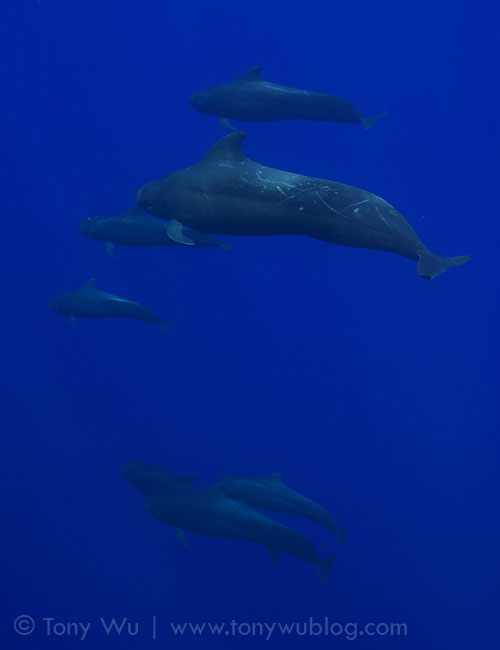
Part of the squadron of pilot whales
Pilot whales can be vicious, acting like pack hunters and tearing their prey to bits and pieces. I think Lele's mother heard the squadron of cetaceans approaching and took her baby to safety.
We, of course, jumped in. The pilot whales weren't terribly friendly, but they didn't really avoid us either. They were mixed in with two adult humpback whales…playing together.
I've seen dolphins descend upon humpbacks many times, and in every instance, the whales weren't happy. I think hyperactive dolphins are to humpbacks what a frenzy of mosquitoes are to me…annoying and irritating. Something you want to swat.
In the case of the pilots, however, the humpbacks were clearly enjoying themselves…swimming in seemingly choreographed patterns, rolling in and out of the pack.
Once again, the best way I can describe what we saw is…the humpbacks and pilots were enjoying themselves. They were having fun, just like groups of kids meeting at a park. I have to anthropomorphise, because…there's no other plausible explanation.
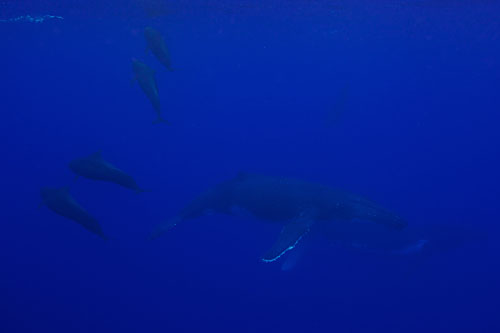
I was too far away to get a better photo.
Then came the ocean whitetip sharks. Two of them, trailing behind the pilot whales. The first approached to check me out, then turned away after it decided I wasn't an easy meal. The streamlined predators hung around for the entire encounter though, periodically coming back to make they hadn't inadvertently passed up a tasty snack.
We conjectured that the oceanics may have been trailing the pilots hoping to pick up scraps for an easy meal.
On another drop, a striped marlin joined the fray, swimming most closely to Serene, then checking the rest of us out before heading on. "Nothing interesting here", I could almost hear it thinking with a despondent sigh.
Given the unusually high number of whale shark sightings we've had in Vava'u this season (something on the order of seven), we half expected one of the enormous fish to turn up, but unfortunately, no whale shark swam past.
We certainly couldn't complain though, given how much we saw that day. It was literally, "Everything but the whale shark".
To Be Continued
So much happened that this post is getting really long, even though I'm doing my best to edit out a lot. I'll split the rest into another post.
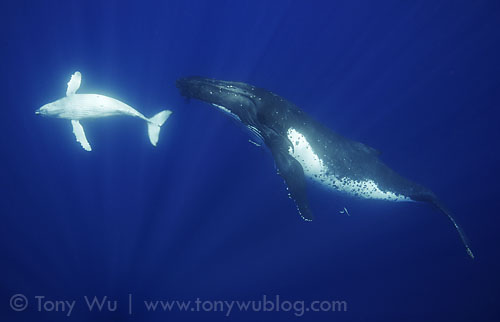
Geri (7th ID-ed humpback whale calf) with mother
Related Posts
Humpback Whales in Tonga 2010 | Part 1
Humpback Whales in Tonga 2010 | Part 2
Humpback Whales in Tonga 2010 | Part 3
Humpback Whales in Tonga 2010 | Part 4
Humpback Whales in Tonga 2010 | Part 6
Humpback Whales in Tonga 2010 | Part 7
Humpback Whales in Tonga 2010 | Part 8